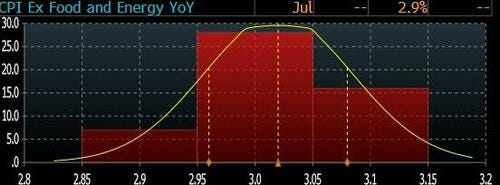As the bustling city of New York wakes to the rhythm of its regular hustle, a momentous event is about to unfold in the financial district. With the clock striking 8:30 a.m., the Bureau of Labor Statistics is set to unveil the much-anticipated July Consumer Price Index (CPI) figures. This release is not just another statistic for market enthusiasts; it is perceived as the final hurdle before a significant monetary policy decision by the Federal Reserve.
A twist in the tale comes with the arrival of a new head at the Bureau, an individual whose past remarks have been somewhat critical of the existing state of affairs. This change at the helm has infused a sense of unrest among traders, raising suspicions that today’s figures might shed the conventional polish for a more stark and revealing truth.
Investors are on edge, as the consensus leans heavily—registering an 80.6% probability—towards a 25 basis point rate adjustment by the Fed in September. However, this expectation comes with a crucial caveat: the inflation data must not exceed a certain threshold. A monthly increase in CPI above 0.40% would shatter the fragile peace the market has found in a dovish narrative, potentially reinstating a hawkish foundation for Federal Reserve policies going forward.
The consensus forecast paints a relatively tranquil picture: a modest monthly rise in the overall CPI of +0.2% (down from the previous month’s +0.3%), with annual inflation anticipated to edge up to 2.8% from 2.7%. The core CPI, which excludes volatile food and energy prices, is expected to tick up to +0.3% on a monthly basis (from +0.2%), with its year-on-year increase climbing to 3.0% from 2.9%. Notably, the predictions show a significant tilt towards higher inflation, with anticipations of 3.1% nearly doubling those of 2.9%.
This skew towards higher expectations underscores the prevailing uncertainty and highlights the upside risks that an unexpected surge in inflation poses. After four consecutive months of softer-than-expected inflation figures, any sharp increase could potentially alter the ongoing discussions and strategies surrounding monetary policy.
This latest CPI release also serves as a litmus test for gauging the impact of recent tariff implementations by the Trump administration on U.S. consumer prices. Over the past few months, the brunt of these tariffs has been borne upstream by foreign producers. However, we are now at a juncture where the effects might start to visibly permeate through to the retail shelves in the United States, affecting everything from furniture and appliances to electronics.
Analysts are closely monitoring categories like used car prices, which are expected to see an uptick, influenced by rising auction costs. Conversely, new car prices might witness a slight dip due to increased dealership incentives. Airfares are predicted to rise, challenging the balance between seasonal adjustments and persistent demand. Furthermore, tariffs are expected to have a tangible impact on household goods and recreational equipment prices, albeit minimally.
If the CPI components follow these predicted paths, we could be looking at a steady core inflation rate in the coming months, with significant contributions from the recent tariffs. Analysts from Goldman Sachs estimate half of this potential increase to be a direct result of tariff-induced distortions, with the remaining attributed to the fading effects of past inflationary pressures. Without tariffs, projections suggest a return to the Federal Reserve’s 2.5% inflation target by 2026—a scenario emblematic of achieving a key policy objective.
Yet the inclusion of tariffs in the economic equation complicates the outlook, presenting a more challenging narrative for policymakers to navigate. Moreover, the labor market presents its own set of puzzles, with recent trends suggesting enough instability to embolden dovish stances within the Federal Reserve, despite persistent inflation exceeding target levels.
Figures like Neel Kashkari have voiced a preference for proactive rate cuts, reversible should the situation demand, signaling a readiness to confront uncertainties head-on. Others, such as Mary Daly, assert the urgency of action, hinting at a rate adjustment in September as almost a foregone conclusion. This juxtaposition of views amidst uncertain economic indicators underscores the delicacy of the Fed’s upcoming decisions.
With market participants bracing for volatility, today’s CPI figures could very well dictate the tone and direction of monetary policy in the near term. An unexpectedly high inflation rate would challenge the prevailing market calm, potentially signaling the end of an era of relative stability and the beginning of a more volatile chapter in monetary policy and market dynamics. This transition brings to light the intricate dance between managing inflationary pressures and nurturing economic growth—a balance the Federal Reserve aims to master as it navigates through these uncertain times.


